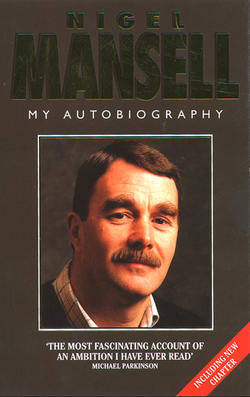Читать книгу Mansell: My Autobiography - Nigel Mansell - Страница 8
ОглавлениеPREFACE
Nigel Mansellâs life is a wonderful example of the triumph of the human spirit over adversity. He has overcome enormous hurdles throughout his career thanks to an indomitable will, total self-belief and a burning desire to succeed.
All top Grand Prix drivers are heroes, you just have to stand by the side of the track during a race weekend to see that. But Nigel stands out from the crowd for his commitment, his determination and his natural showmanship. His force of will is apparent in everything he does. I once played against him in a soccer match for journalists, photographers and drivers on the eve of the Spanish Grand Prix in 1991, a week after the pit stop fiasco in Portugal, where Nigelâs hopes of beating the great Ayrton Senna to the World Championship had followed his errant rear wheel down the pit lane.
Most of the players were there for fun, either a bit long in the tooth or too fond of their beer to be fully competitive, but Nigel played as if his life depended on it, crashing into every tackle and chasing every ball. His day ended in a twisted ankle, which swelled up like a grapefruit. He won the race that weekend of course. His injury was not play-acting, but a perfect illustration of how accident-prone the man is.
The chronicling of Nigel Mansellâs career has always been uneven. A mismatch of personalities between him and many of my colleagues in the world of journalism has led him in for some heavy criticism, some of it justified, some of it no more than blind insults. I have always been sceptical about the criticism that Nigel has come in for and fascinated to know what really makes him tick. It struck me that, although a huge public feels it can identify with him, there are very few people in the sport who actually understand what he is all about.
Nigel and I spent over 16 months devising, developing and refining this book in order to make it the definitive text on his life and racing career. In these pages Nigel explains for the first time what lies behind his philosophy of life and his psychological approach to the sport he loves. A great deal of archive research was undertaken and over 30 hours of interviews carried out with people close to Nigel. Time after time fascinating revelations from them prompted equally fascinating reflections from Nigel. We have included some of the more revealing comments, where appropriate, as notes at the end of each chapter.
Sifting through all the evidence, I believe that the starting point for understanding Nigel Mansell lies in two comments made by Williamsâ director Patrick Head and Formula 1 promoter Bernie Ecclestone, when interviewed for this book. Bernie, who knows and understands Nigel better than most in the Formula 1 pit lane, said that he is âa very simple, complex personâ while Patrick described Nigel as ânot a driver who takes well to not-winningâ. The veracity of these two statements is there for all to see in Nigelâs own words in this book.
He is a great champion who has not been fully appreciated in his own time and perhaps it will only be in history, provided it is objectively written, that the full achievement of Nigel Mansell will come to be recognised.
I am greatly indebted to Nigelâs many friends and colleagues who gave me information and insights and who pointed me towards the right areas to probe.
I would like to thank Murray Walker, Bernie Ecclestone, Gerald Donaldson, David Price, John Thornburn, Chris Hampshire, Sue Membery, Grant Bovey, Sally Blower, Anthony Marsh, Creighton Brown, Patrick Mackie, Mike Blanchet, Nigel Stroud, Frank Williams, Patrick Head, David Brown, Cesare Fiorio, Carl Haas, Paul Newman, Peter Gibbons, Bill Yeager, Derek Daly, Gerhard Berger, Keke Rosberg and Niki Lauda.
Special thanks to Peter Collins, Peter Windsor and Jim McGee for devoting a lot of time and help with my research, and to Rosanne Mansell for the stories, help with the editing and copious cups of tea. I am also greatly indebted to my father, Bill, and Sheridan Thynne for laboriously studying the draft manuscripts and making helpful suggestions.
Thanks also to the folks at CollinsWillow: Michael, Rachel and Monica and especially to Tom Whiting for an excellent piece of editing; Alberta Testanero at Soho Reprographic in New York; Bruce Jones at Autosport magazine for use of the archive; Andrew Benson for archive material and Rosalind Richards and the Springhead Trust; Ann Bradshaw, Paul Kelly and Andrew Marriott for their support; Pip for keeping me sane; and to my parents Bill and Mary and my sister Sue.
Most of all, I would like to thank Nigel for giving me the opportunity to write this book with him and for opening the door and allowing me in.
James Allen
Holland Park, London
